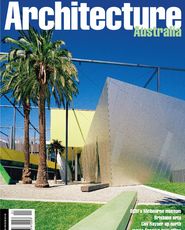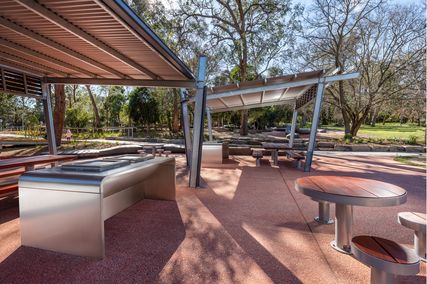Photos David Sandison.
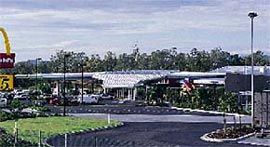
Overview of the Coomera BP, the linear version of Arkhefield’s new model, showing the canopy folding down to create an intimate scale at the building entrance.
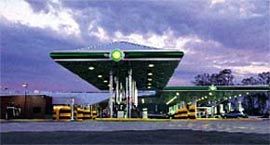
The truck canopy at the Stapylton BP, the perpendicular version, with the new BP “star” logo.
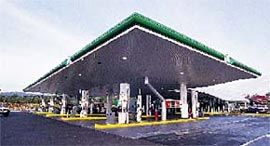
Coomera front canopy.
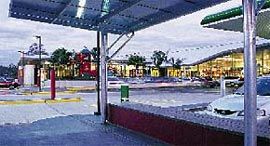
Stapylton food court.
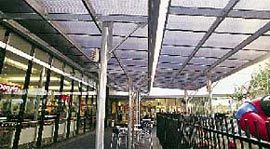
Coomera outdoor dining area.
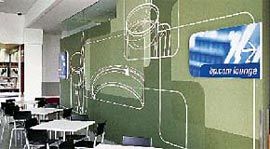
Coomera food hall and lounge.
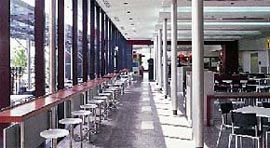
Stapylton outdoor dining area.
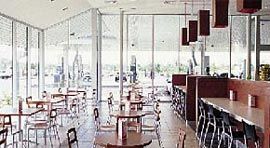
Coomera coffee shop.
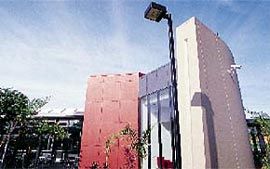
Exterior view of the communications lounge at Coomera, showing the massive rendered block wall used to end the linear model.
The humble petrol station is undergoing something of an architectural renaissance.
Repsol petrol stations designed by Norman Foster are to appear on 200 sites throughout Spain. Fitch Design and the Conran Design Group are working on the retail repackaging of Shell International. BP Australia has joined the international trend with five new travel centres designed by the Brisbane practice Arkhefield.
The reconfiguration of the Pacific Motorway connecting the Gold Coast and Brisbane, and major work on the Bruce Highway travelling north from Brisbane to the Sunshine Coast, meant that new travel centres were needed for each zone along these busy stretches of the national road system. In preparing their public tender, BP Australia came to realise that nothing in their standard kit of parts could meet the brief set by the Queensland Government’s Main Roads Department. Forty percent of the government’s assessment criteria for the tender was based on design, and BP recognised the need to seek external design expertise. Arkhefield were invited onto the tender team. The result is a new model that redefines the expectations and experience of the travel centre.
Two variations of the new model – one linear and one perpendicular – satisfy the different conditions of the five sites. The Coomera Travel Centre, opened in October 2000, is the linear version, with the broad entry canopy over the forecourt linking straight through to the facilities within. The Stapylton Travel Centre, opened in early November 2000, places the facilities perpendicular to the entry canopy. Each travel centre incorporates a BP Connect (the newly branded convenience store), interactive tourist information bureau, communications lounge, food hall, cafe and truckers facilities.
In both variations, the entry canopy is directly linked with the facilities building.
This was something of a brave move by the design team, as accepted retailing wisdom required that the dispensing of fuel and food be kept quite separate – in both a practical and visual sense. The “grudge” purchase of fuel should not contaminate the “gratification” purchase of food.
To overcome the pitfalls of linking the various functions, the internal elements had to be so unlike the usual experience of a petrol station that the travel centre would be fully dissociated from the fuel purchasing experience. This has been achieved by a skilful interior fitout that has more in common with a sleek modern airport lounge than the petrol stations of the past. High ceilings, clerestory windows, generously spaced seating, effective task lighting, sophisticated graphics and well considered spatial divisions clearly differentiate these architecturally “fresh” travel centres from the bain-marie and crumbed fish experience of the ancient servo.
In terms of motorway appeal, it is the sleek and streamlined canopy that catches the eye and remains as the iconic image of the new centres. Initially, the architects were instructed to not touch the canopy, as the traditional stand-alone model was considered to be a significant part of BP’s branding. A merger between BP and Amoco during the project’s development gave the scope to explore new canopy forms. The resulting winged canopy is seen as an important place-making device, successfully mediating the massive scale of the forecourt with the more intimate scale of the building beyond.
The canopy drove the form of the building. Fifty metres long and twenty metres wide over the forecourt, the canopy folds down in a wing-like motion as it swoops in over the facilities building, creating a welcoming scale and announcing the direct entry area off the side car park.
In the linear version at Coomera, the building is bought to a strong conclusion by a massive rendered block wall. This element contrasts strongly with the transparency of the glazed walls required by the retail functions.
Arkhefield have successfully remade the prosaic petrol station into a sophisticated travel centre, and in doing so have created an architecture of visual interest and significant presence. The result is a remarkably pleasurable place that ably supports the Main Roads Department’s appeal that drivers rest, revive and survive.
Dr Paula Whitman is a lecturer in architecture at Queensland University of Technology.

